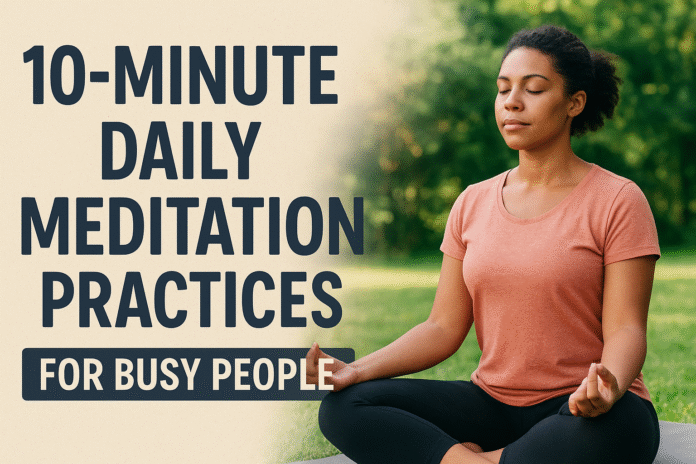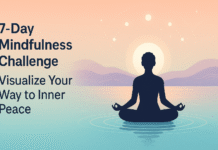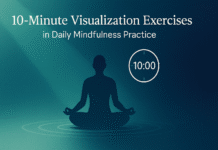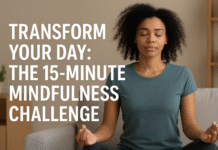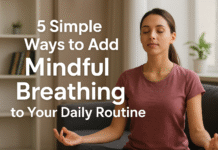If you have ten minutes, you can start a daily meditation habit that measurably improves focus, lowers stress, and strengthens emotional resilience. 10-Minute Daily Meditation Practices for Busy Individuals shows you exactly how to build short, sustainable sessions into a packed day, which styles work best for different contexts, how to measure progress, and a simple 4-week starter plan so your practice sticks. This article is for busy professionals, parents, students, and anyone who wants real mental benefits without long sessions.
Medical disclaimer: This article provides general wellness information, not medical advice. If you have a medical or mental-health condition (for example, severe depression, PTSD, or anxiety disorders), consult a qualified health professional before starting a meditation program.
Key takeaways
- Ten minutes daily is powerful. Short, consistent sessions provide measurable improvements in mood, attention, and stress response.
- Multiple styles fit different moments. Breath awareness, guided audio, loving-kindness, body scan, and walking meditation each serve distinct needs.
- Habit beats duration. Consistency for 4–8 weeks produces noticeable change; scale time later.
- Practical tools and tracking help. Use a timer, short apps, and a simple journal to track progress and keep motivated.
Why ten minutes works: the science and logic behind short daily sessions
What it is and core benefits or purpose
A ten-minute meditation is a focused, intentional period of attention or awareness practice performed daily. Its core purpose is to create a small, reliable “reset” in which your nervous system can down-regulate stress responses, and your attention systems can practice returning to an anchor (like the breath). Research shows that regular short sessions can reduce symptoms of anxiety and depression, improve attentional control, and motivate healthier behaviors over time. PsyPost – Psychology News
Why ten minutes instead of longer
Short sessions lower friction for busy people: they are easier to commit to, less likely to be skipped, and still deliver measurable acute and cumulative benefits. Several trials and reviews indicate that even single 10-minute guided practices can produce immediate improvements in attention and mood, and that daily 10-minute regimens over weeks produce sustained changes. Longer sessions can be more potent for certain outcomes, but consistency is the most reliable lever for busy schedules.
Requirements/prerequisites and low-cost alternatives
- Time: 10 minutes.
- Space: anywhere you can sit, lie down, or walk safely.
- Tools: optional timer or smartphone with a quiet mode. Free guided audio is widely available.
No special equipment or fees are required; free apps and web audio provide high-quality guidance.
How often and when
Daily is ideal. Aim for 10 minutes every day; if that’s impossible, two 5-minute sessions split across the day are almost as effective. Short morning sessions set tone for the day, while evening sessions help with unwinding—choose what you will actually do and prioritize consistency.
Safety, caveats, and common mistakes
- Expect wandering thought. It’s the practice to notice and return, not to eliminate thought.
- If you have trauma history, some techniques (intense open awareness or body scans) can be unsettling; proceed with trauma-informed guidance if needed.
- Falling asleep in sessions is common—try sitting up or choose walking meditation.
- Perfectionism (expecting sensations or “progress” every day) undermines habit. Keep sessions simple and forgiving.
Short sample mini-plan (2–3 steps)
- Set a 10-minute timer.
- Sit upright, focus on the breath.
- When distracted, note the thought and gently return to breath.
Breath Awareness Meditation (10 minutes)
What it is and core benefits
Breath awareness centers attention on the natural flow of inhalation and exhalation. It reliably lowers physiological markers of stress, calms the nervous system, and strengthens attentional control—especially useful for high-stress moments or as a daily anchor practice.
Requirements/prerequisites and low-cost alternatives
- Quiet seat (chair, cushion) or standing.
- Timer (phone) or silent clock.
No paid tools required; you can use a simple stopwatch.
Step-by-step instructions (beginner-friendly)
- Sit comfortably with a straight back and feet on the floor.
- Set a timer for 10 minutes.
- Close or lower your eyes. Notice a few natural breaths without trying to change them.
- Choose an anchor: the sensation at the nostrils, or the rise and fall of the belly.
- When a thought arises, silently note it (for example, “thinking”) and return to the breath.
- At the timer, take one full breath and open eyes slowly.
Beginner modifications and progressions
- Modify: Start with 5 minutes and work up to 10.
- Progress: Add a counting refinement (count inhale 1, exhale 1 up to 4, then repeat) or extend to 12–20 minutes as your schedule allows.
Recommended frequency/duration/metrics
- Daily, 10 minutes. Track sessions completed per week and subjective calm before/after (simple 1–5 scale). Expect incremental improvements after 4–8 weeks.
Safety, caveats, and common mistakes
- Forcing breath rhythms can cause dizziness—let breath be natural unless doing intentional breathwork.
- Avoid practicing lying down if you fall asleep easily.
- Mistake: judging the session as “bad” because of many thoughts—this is normal.
Sample mini-plan (2–3 steps)
- Sit for 10 minutes, breathe naturally.
- Return to breath whenever distracted.
Guided Meditation (App-Assisted, 10 minutes)
What it is and core benefits
Guided meditations use recorded instruction to lead attention, structure breathing, or prompt reflections or imagery. For beginners, guided audio lowers barriers—studies of app-delivered programs typically instruct users to practice around 10 minutes daily and show reductions in stress and improvements in well-being.
Requirements/prerequisites and low-cost alternatives
- Smartphone or computer with audio.
- Optional headphones.
Many high-quality guided meditations are free via dedicated apps or public audio libraries.
Step-by-step instructions (beginner-friendly)
- Choose an app or audio (10-minute beginner session).
- Find a comfortable, quiet spot.
- Press play, follow voice cues, and maintain open, nonjudgmental attention.
- When the guide ends, take 30 seconds to notice sensations before resuming activity.
Beginner modifications and progressions
- Modify: If you struggle to sit, use audio while walking slowly (walking guided meditations exist).
- Progress: Move from strictly guided to partially guided to silent sessions over months.
Recommended frequency/duration/metrics
- Daily, 10 minutes. Track number of sessions completed weekly and perceived stress via a quick scale. App usage data (session counts) can be used as objective metrics.
Safety, caveats, and common mistakes
- Don’t multitask; guided sessions are less effective if you’re doing chores while listening.
- Relying exclusively on one app may create dependence—learn to practice without guidance eventually.
Sample mini-plan (2–3 steps)
- Launch a 10-minute beginner guided session.
- Listen quietly and follow the instructor.
Loving-Kindness (Metta) Meditation (10 minutes)
What it is and core benefits
Loving-kindness practice involves silently repeating phrases that cultivate goodwill toward yourself and others. It increases positive emotions, social connectedness, and emotion regulation. Short sessions can shift mood and build compassion over time.
Requirements/prerequisites and low-cost alternatives
- Comfortable seat, eyes closed or softened.
- Optional guided loving-kindness audio.
No cost beyond a quiet space.
Step-by-step instructions (beginner-friendly)
- Sit upright for 10 minutes.
- Begin with yourself: repeat gentle phrases like “May I be safe. May I be healthy. May I be happy.” in a slow rhythm.
- After a few minutes, direct the phrases to a loved one, then to a neutral person, and finally to someone difficult (only if emotionally ready).
- End by widening goodwill to all beings.
Beginner modifications and progressions
- Modify: If extending kindness to others feels hard, spend the full session on self-directed phrases.
- Progress: Gradually include more categories of people and refine the emotional texture of the phrases.
Recommended frequency/duration/metrics
- Daily, 10 minutes or 3–4 times weekly. Track self-reported compassion and reactivity in a short weekly note. Some people notice increased positive affect in weeks.
Safety, caveats, and common mistakes
- If the practice triggers uncomfortable feelings (e.g., grief or anger), pause and seek gentle guidance.
- Mistake: forcing emotion; the practice works through repetition, not performance.
Sample mini-plan (2–3 steps)
- Sit 10 minutes, repeat self-directed phrases.
- Extend phrases to one other person.
Body-Scan Meditation (10 minutes)
What it is and core benefits
A body scan guides attention systematically through body parts, noticing sensation without judgment. It reduces stress, eases sleep onset, and improves body awareness—useful for settling into the evening or calming an anxious system. Harvard Health
Requirements/prerequisites and low-cost alternatives
- Quiet space, optionally lying down.
- Guided audio helpful but not required.
Step-by-step instructions (beginner-friendly)
- Lie down or sit comfortably.
- Set a 10-minute timer.
- Start at your feet; notice sensations (warmth, pressure, tingling) without trying to change them.
- Slowly move attention up the legs, pelvis, torso, arms, neck, and head.
- End with whole-body awareness and slow breath.
Beginner modifications and progressions
- Modify: Scan only lower or upper body for 5 minutes if attention drifts.
- Progress: Extend to 15–30 minutes for deeper relaxation or add subtle breath coordination.
Recommended frequency/duration/metrics
- 3–7 times per week, especially helpful before sleep. Note sleep latency and subjective sleep quality as metrics (simple 1–5 scales). ScienceDirect
Safety, caveats, and common mistakes
- If the body scan uncovers trauma-related sensations, stop and seek support.
- Avoid scanning while driving or standing.
Sample mini-plan (2–3 steps)
- Lie down for 10 minutes guided body scan.
- Finish with three slow, grounding breaths.
Walking Meditation (10 minutes)
What it is and core benefits
Walking meditation brings mindfulness into motion—attending to the sensation of each step and the rhythm of movement. It’s ideal when sitting is impractical and helps cultivate embodied attention and refresh focus between tasks.
Requirements/prerequisites and low-cost alternatives
- Safe, quiet place to walk (hallway, park).
- Comfortable shoes if needed.
Step-by-step instructions (beginner-friendly)
- Walk slowly and deliberately for 10 minutes.
- Pay attention to the sequence of lift—move—place in each foot.
- Bring awareness to breath and posture.
- If mind wanders, return to the sensations of stepping.
Beginner modifications and progressions
- Modify: Do two 5-minute walks if you can’t allocate 10 minutes at once.
- Progress: Increase tempo awareness or coordinate steps with inhale/exhale counts.
Recommended frequency/duration/metrics
- Daily or as needed, especially as a mid-day reset. Track clarity and stress before/after a walking session.
Safety, caveats, and common mistakes
- Choose a safe route and avoid hazardous settings (traffic, uneven terrain).
- Mistake: moving too quickly—slowing down is the point.
Sample mini-plan (2–3 steps)
- Walk 10 minutes, attend to each step.
- Finish with a brief stillness to note changes.
Practical Add-Ons for Busy Practitioners
Quick-start checklist / warm-up
- Block 10 minutes on your calendar (treat it as an appointment).
- Turn phone to Do Not Disturb and set a simple timer.
- Choose a style (breath, guided, loving-kindness, body scan, walking).
- Start with a single intention (e.g., “I’ll be present for ten minutes”).
Troubleshooting & common pitfalls
- Problem: I can’t sit still. Fix: Try walking meditation or 5-minute bursts.
- Problem: I keep falling asleep. Fix: Sit upright or practice earlier in the day.
- Problem: I forget daily. Fix: Anchor practice to an existing routine (after brushing teeth, before coffee).
- Problem: I don’t feel anything. Fix: Track small metrics (post-session calm 1–5) to notice subtle changes over weeks.
How to measure progress or results
- Use a simple daily log with three fields: minutes practiced, stress level before, stress level after (1–5).
- Weekly review: count sessions/week, average before/after delta.
- Quarterly reflection: look for changes in sleep onset, emotional reactivity, or ability to focus at work.
A simple 4-week starter plan (roadmap)
Week 1 — Build the habit
- Goal: 5–10 minutes every day. Use breath awareness. Track sessions in a journal.
Week 2 — Stabilize and experiment
- Goal: 10 minutes daily. Try guided meditations three times this week. Note immediate mood shifts.
Week 3 — Add variety
- Goal: Alternate breath, loving-kindness, and body scan across days. Start tracking a single KPI (e.g., ability to return to task after distraction).
Week 4 — Solidify and evaluate
- Goal: 10 minutes daily. Add one walking meditation session. Review your weekly log, celebrate consistency, and plan next step (e.g., extend select sessions to 15 minutes).
Consistency across these four weeks is a stronger predictor of long-term benefit than occasional long meditations. Many app-based and web trials instruct users to practice around 10 minutes per day across 8 weeks to see clinical-level changes.
Scaling up: progressions and how to grow your practice
- From 10 to 15–20 minutes: Add 1–2 extra minutes each week.
- From guided to silent: Gradually reduce guidance minutes inside sessions (e.g., use a 10-min guide for 2 weeks, then alternate guide/silent).
- To deeper reflection: Keep a short after-session journal (one sentence: “What changed?”).
- Add micro-practices: Two 1-minute pauses during busy meetings or before stressful phone calls compound benefits.
Research comparing 10- and 20-minute sessions finds measurable advantages at longer durations for some people, though many benefits appear with as little as 10 minutes. Choose a gradual progression that fits your life and energy level.
Integrating meditation into a hectic schedule
- Anchor to routines: Combine meditation with an existing habit (after morning coffee or before bedtime).
- Micro-meditations: Use 30- to 60-second breath checks when transitioning tasks. These are easier to commit to and maintain momentum.
- Workplace use: Ten-minute midday sessions reduce perceived stress and restore attention between meetings; some corporate studies use 10-minute digital interventions for employees.
FAQs (10)
1. Will 10 minutes really help me, or should I aim for 20–30 minutes?
Yes—consistent 10-minute daily practice produces meaningful benefits for attention and mood. If you have the time later, you can increase duration, but habit formation is the primary driver of gains.
2. How quickly will I see results?
Some people report immediate calm after a session. More durable changes (reduced anxiety, better focus) typically emerge after several weeks of consistent practice—commonly 4–8 weeks in intervention studies. Harvard Health
3. Is guided meditation better for beginners?
Guided meditations lower barriers and provide structure, making them an excellent starting point. Use them until you feel confident practicing silently.
4. What’s the best time of day to practice?
There’s no single “best” time—pick a time you can stick to. Morning sessions can set the day’s tone; evenings help with relaxation.
5. Can meditation replace therapy or medication?
Meditation supports mental health but is not a replacement for necessary clinical treatments. If you have an ongoing psychiatric diagnosis or are on medication, consult a professional before changing treatment. (See disclaimer above.)
6. I get emotional during loving-kindness practice—what do I do?
Emotional responses can be normal. Pause, breathe, and if emotions are intense or persistent, consult a mental-health provider or try a gentler practice like breath awareness.
7. Are there risks to meditation?
For most people, meditation is safe. However, certain intensive practices or open awareness can be destabilizing for trauma survivors—seek trauma-informed guidance if that applies.
8. How should I track progress?
A simple daily log with minutes practiced and a before/after 1–5 stress or clarity rating is effective and takes one minute. Apps can also log usage automatically.
9. What if I miss a day?
Don’t worry. Missed sessions happen—resume the next day. Habit is built over time, not by perfection.
10. Are short sessions supported by research?
Yes—multiple studies and trials show benefits from brief daily sessions, including improvements in attention, mood, and reductions in anxiety and depression symptoms.
Troubleshooting common challenges
Problem: I can’t sit still for 10 minutes.
Solution: Start with two 5-minute sessions or try walking meditation. Movement often helps anchor attention without the pressure to remain still.
Problem: My mind races and I feel frustrated.
Solution: Practice nonjudgmental noting: silently label distractions (“thinking,” “planning”) and return to the anchor. Track progress—over weeks, interruptions typically reduce.
Problem: I fall asleep during sessions.
Solution: Sit upright or switch to a standing/walking practice. Avoid heavy meals right before practice.
Problem: I don’t have privacy at home.
Solution: Use noise-reducing headphones and guided audio or practice in short micro-sessions (1–3 minutes) that are more discreet.
Conclusion
Ten minutes a day is a realistic, scientifically supported way for busy individuals to build mental clarity, emotional balance, and resilience. These practices are flexible—pick a style that fits your day (breath awareness, guided audio, loving-kindness, body scan, or walking) and focus on consistency. Track your practice, be patient with the process, and scale up thoughtfully when it fits your life.
Call to action: Start today—set a 10-minute appointment with yourself and try one practice from this guide.
References
- Efficacy of the Mindfulness Meditation Mobile App “Calm” to Reduce Stress: A Randomized Controlled Trial (PMC), 2019. . PMC
- The effect of ten versus twenty minutes of mindfulness meditation on state mindfulness and anxiety: cross-sectional and experimental evidence, Scientific Reports / PMC, 2023. and . NaturePMC
- Digital Meditation to Target Employee Stress, JAMA Network Open (study summary on workplace digital meditation), 2024–2025. . JAMA Network
- Breath practices for stress and anxiety reduction: effects on autonomic function and neural circuits, PMC (review), 2024. . PMC
- Brief mindfulness meditation improves attention in novices, Frontiers in Psychology / PMC, 2018. . PMC
- Effectiveness of an 8-Week Web-Based Mindfulness Virtual Community: a randomized trial (JMIR Mental Health), 2020. . JMIR Mental Health
- 5 Minutes of Mindfulness Brings Real Benefits, According to Science (Mindful.org), 2023. . Mindful
- App-based mindfulness meditation reduces stress in novice users: randomized controlled trial (Annals of Behavioral Medicine / Oxford Academic), 2025. . Oxford Academic
- Breathwork meta-analysis: Effect of breathwork on stress and mental health, Scientific Reports, 2022. . Nature
- Just 10 minutes of mindfulness daily boosts wellbeing and fights depression, University of Bath (press release), 2024-08-23 (updated 2025-03-07). . University of Bath
- Can Meditation Improve Your Health? Here’s What to Know, Time magazine, 2018. . TIME




























